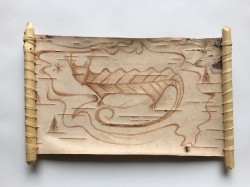Arts | May 17th, 2017

The Plains Art Museum Native American Art Program Director, Laura Youngbird, is pairing with Lise Erdrich to teach a class on Birch Bark Scrolls at the Plains Art Museum on May 18 and 19.
Weaving together stories and words, the Ojibwe tribe wrote stories on birch bark scrolls, known in their native language as wiigwaasbakoon. The class will be free to Native artists as part of the Plains Art Museum’s initiative “Creativity Among Native Artists,” which aims to bring visibility to Native American artists through exhibitions, professional development opportunities, and programming.
Youngbird said, “We will be encouraging participants to create or remember a story that has been passed down to them, and interpret it in a pictograph form or memory device.”
Art is a vital tool for cultural preservation and sharing, expression, and resistance against hardships and oppression. Recently art helped increase visibility around The Dakota Access Pipeline protests, amplifying the importance of the issue to activists across the world. The DAPL protests finally brought issues faced by Native Americans to the forefront.
Another important issue is cultural and linguistic preservation. The Ojibwe people used birch bark scrolls to record religious beliefs, ceremonies, and traditions.
“Lise (Erdrich) and I will be teaching the history and storytelling aspect of the scrolls. It would be inappropriate for us to share the sacred or ceremonial facet associated with the scrolls in a public workshop,” Youngbird stated.
The sacred and ceremonial aspects of the scrolls are complex and culturally sensitive. Some museums and digital preservationists have chosen to return scrolls to their homes with the Ojibwe people. While some scrolls are publicly shown, many museums and websites have chosen to not make the scrolls publicly viewable.
Research conducted by The Society of American Archivists and the National Museum of the American Indians revealed that there was controversy in releasing the scrolls publicly, to those who may misinterpret their meaning. Ojibwe people can use their rich oral traditions and teachings that allow them to properly interpret the pictures and symbols depicted in the scrolls.
An example of the reverence for and power of Ojibwe scrolls occurred regionally in The Bois Forte Reservation, located primarily in Koochiching County in Northern Minnesota. The Minneapolis Star Tribune reported that 275-year-old scrolls were returned to the Bois Forte Reservation in 2006 by a white Kentucky doctor. The doctor claimed his grandfather acquired the scrolls when he was superintendent of Ah-Gwah-Ching tuberculosis sanatorium near Walker, Minn.
Shockingly, tribal elders confirmed the scrolls were “long-lost records of the Bois Forte lodge of the Midewiwin, or Grand Medicine Society, a selective Ojibwe religious order that preserved its rites on birch bark and was driven underground for most of the 20th century, when Indian religions were outlawed by the U.S. government.” The scrolls are so sacred that band’s elder’s decided the scrolls could not be viewed or photographed by people who are not part of their religious order.
The Picture Writing class will be a fun way to honor this tradition in a respectful way. Youngbird says that participants will use deer bone scribes to etch into birch bark.
IF YOU GO
Picture Writing: The Lost Art of Birch Bark Scrolls
Thursday and Friday, May 18 and 19, 3 to 5pm
Katherine Kilbourne Burgum Center for Creativity, 720 1st Ave N
Fargo Free for Native artists (must register); $60 museum members, $80 nonmembers
lyoungbird@plainsart.org or Native American Arts Community on Facebook
December 18th 2025
October 28th 2025
September 16th 2025
August 19th 2025
July 24th 2025

_(1)__293px-wide.jpg)
_(1)_(1)_(1)__293px-wide.jpg)
_(1)__293px-wide.png)
_(1)__293px-wide.png)
__293px-wide.jpg)